CNN经典网络模型:ResNet简介及代码实现(PyTorch超详细注释版)
Posted 华科附小第一名
tags:
篇首语:本文由小常识网(cha138.com)小编为大家整理,主要介绍了CNN经典网络模型:ResNet简介及代码实现(PyTorch超详细注释版)相关的知识,希望对你有一定的参考价值。
目录
一、开发背景
残差神经网络(ResNet)是由微软研究院的何恺明、张祥雨、任少卿、孙剑等人提出的, 斩获2015年ImageNet竞赛中分类任务第一名, 目标检测第一名。 残差神经网络的主要贡献是发现了“退化现象(Degradation)”,并针对退化现象发明了 “直连边/短连接(Shortcut connection)”,极大的消除了深度过大的神经网络训练困难问题。神经网络的“深度”首次突破了100层、最大的神经网络甚至超过了1000层。
二、网络结构
ResNet的前两层为输出通道数为64、步幅为2的7×7卷积层,后接步幅为2的3×3的最大池化层。 不同于GoogLeNet,ResNet在每个卷积层后增加了批量规一化层。接着, ResNet使用4个由残差块组成的模块,每个模块使用若干个同样输出通道数的残差块。 第一个模块的通道数同输入通道数一致。 由于之前已经使用了步幅为2的最大池化层,所以无须减小高和宽。 之后的每个模块在第一个残差块里将上一个模块的通道数翻倍,并将高和宽减半。ResNet的一个重要设计原则是:当feature map大小降低一半时,feature map的数量增加一倍,这保持了网络层的复杂度。最后,输入全局平均汇聚层,以及全连接层输出。通过配置不同的通道数和模块里的残差块数可以得到不同的ResNet模型,例如更深的含152层的ResNet-152。34层ResNet如下图所示:

残差单元(残差块)
ResNet团队分别构建了带有“直连边(Shortcut Connection)”的ResNet残差块、以及降采样的ResNet残差块,区别是降采样残差块的直连边增加了一个1×1的卷积操作。对于直连边,当输入和输出维度一致时,可以直接将输入加到输出上,这相当于简单执行了同等映射,不会产生额外的参数,也不会增加计算复杂度。但是当维度不一致时,这就不能直接相加,通过添加1×1卷积调整通道数。这种残差学习结构可以通过前向神经网络+直连边实现, 而且整个网络依旧可以通过端到端的反向传播训练。结构如下图所示:
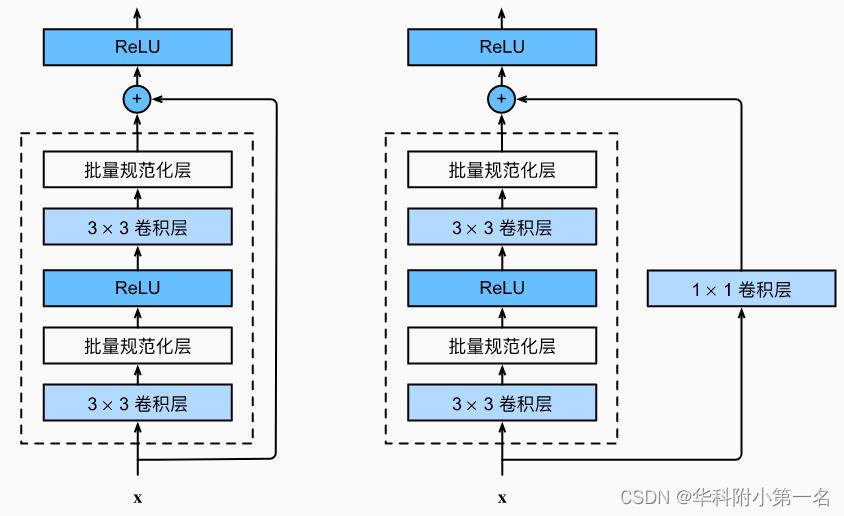
三、模型特点
1.超深的网络结构(突破1000层)
网络深度为什么重要?因为CNN能够提取low/mid/high-level的特征,网络的层数越多,意味着能够提取到不同level的特征越丰富。并且,越深的网络提取的特征越抽象,越具有语义信息。
2.使用Batch Normalization
为什么不能简单地增加网络层数?对于原来的网络,如果简单地增加深度,会导致梯度弥散或梯度爆炸。Batch Normalization可以解决该问题的,因此可以训练到几十层的网络。
3.残差块
随着网络层数增加,出现了新的问题:退化问题,在训练集上准确率饱和甚至下降了。这个不能解释为过拟合,因为过拟合表现为在训练集上表现更好才对。退化问题说明了深度网络不能很简单地被很好地优化。作者通过实验说明:通过浅层网络y=x 等同映射构造深层模型,结果深层模型并没有比浅层网络有更低甚至等同的错误率,推断退化问题可能是因为深层的网络很那难通过训练利用多层网络拟合同等函数。
怎么解决退化问题?深度残差网络。如果深层网络的后面那些层是恒等映射,那么模型就退化为一个浅层网络。所以要解决的就是学习恒等映射函数。但是直接让一些层去拟合一个潜在的恒等映射函数H(x) = x,比较困难,这可能就是深层网络难以训练的原因。但是,如果把网络设计为H(x) = F(x) + x。我们可以转换为学习一个残差函数F(x) = H(x) - x. 只要F(x)=0,就构成了一个恒等映射H(x) = x. 此外,拟合残差会更加容易。
总的来说,一是其导数总比原导数加1,这样即使原导数很小时,也能传递下去,能解决梯度消失的问题; 二是y=f(x)+x式子中引入了恒等映射(当f(x)=0时,y=2),解决了深度增加时神经网络的退化问题。
4.结构简单
虽然ResNet的主体结构跟GoogLeNet类似,但ResNet结构更简单,修改也更方便,因此ResNet迅速被广泛使用。
四、代码实现
- model.py :定义ResNet网络模型
- train.py:加载数据集并训练,计算loss和accuracy,保存训练好的网络参数
- predict.py:用自己的数据集进行分类测试
- spilit_data.py:划分给定的数据集为训练集和测试集
1. model.py
import torch.nn as nn
import torch
# 定义ResNet18/34的残差结构,为2个3x3的卷积
class BasicBlock(nn.Module):
# 判断残差结构中,主分支的卷积核个数是否发生变化,不变则为1
expansion = 1
# init():进行初始化,申明模型中各层的定义
# downsample=None对应实线残差结构,否则为虚线残差结构
def __init__(self, in_channel, out_channel, stride=1, downsample=None, **kwargs):
super(BasicBlock, self).__init__()
self.conv1 = nn.Conv2d(in_channels=in_channel, out_channels=out_channel,
kernel_size=3, stride=stride, padding=1, bias=False)
# 使用批量归一化
self.bn1 = nn.BatchNorm2d(out_channel)
# 使用ReLU作为激活函数
self.relu = nn.ReLU()
self.conv2 = nn.Conv2d(in_channels=out_channel, out_channels=out_channel,
kernel_size=3, stride=1, padding=1, bias=False)
self.bn2 = nn.BatchNorm2d(out_channel)
self.downsample = downsample
# forward():定义前向传播过程,描述了各层之间的连接关系
def forward(self, x):
# 残差块保留原始输入
identity = x
# 如果是虚线残差结构,则进行下采样
if self.downsample is not None:
identity = self.downsample(x)
out = self.conv1(x)
out = self.bn1(out)
out = self.relu(out)
# -----------------------------------------
out = self.conv2(out)
out = self.bn2(out)
# 主分支与shortcut分支数据相加
out += identity
out = self.relu(out)
return out
# 定义ResNet50/101/152的残差结构,为1x1+3x3+1x1的卷积
class Bottleneck(nn.Module):
# expansion是指在每个小残差块内,减小尺度增加维度的倍数,如64*4=256
# Bottleneck层输出通道是输入的4倍
expansion = 4
# init():进行初始化,申明模型中各层的定义
# downsample=None对应实线残差结构,否则为虚线残差结构,专门用来改变x的通道数
def __init__(self, in_channel, out_channel, stride=1, downsample=None,
groups=1, width_per_group=64):
super(Bottleneck, self).__init__()
width = int(out_channel * (width_per_group / 64.)) * groups
self.conv1 = nn.Conv2d(in_channels=in_channel, out_channels=width,
kernel_size=1, stride=1, bias=False)
# 使用批量归一化
self.bn1 = nn.BatchNorm2d(width)
# -----------------------------------------
self.conv2 = nn.Conv2d(in_channels=width, out_channels=width, groups=groups,
kernel_size=3, stride=stride, bias=False, padding=1)
self.bn2 = nn.BatchNorm2d(width)
# -----------------------------------------
self.conv3 = nn.Conv2d(in_channels=width, out_channels=out_channel * self.expansion,
kernel_size=1, stride=1, bias=False)
self.bn3 = nn.BatchNorm2d(out_channel * self.expansion)
# 使用ReLU作为激活函数
self.relu = nn.ReLU(inplace=True)
self.downsample = downsample
# forward():定义前向传播过程,描述了各层之间的连接关系
def forward(self, x):
# 残差块保留原始输入
identity = x
# 如果是虚线残差结构,则进行下采样
if self.downsample is not None:
identity = self.downsample(x)
out = self.conv1(x)
out = self.bn1(out)
out = self.relu(out)
out = self.conv2(out)
out = self.bn2(out)
out = self.relu(out)
out = self.conv3(out)
out = self.bn3(out)
# 主分支与shortcut分支数据相加
out += identity
out = self.relu(out)
return out
# 定义ResNet类
class ResNet(nn.Module):
# 初始化函数
def __init__(self,
block,
blocks_num,
num_classes=1000,
include_top=True,
groups=1,
width_per_group=64):
super(ResNet, self).__init__()
self.include_top = include_top
# maxpool的输出通道数为64,残差结构输入通道数为64
self.in_channel = 64
self.groups = groups
self.width_per_group = width_per_group
self.conv1 = nn.Conv2d(3, self.in_channel, kernel_size=7, stride=2,
padding=3, bias=False)
self.bn1 = nn.BatchNorm2d(self.in_channel)
self.relu = nn.ReLU(inplace=True)
self.maxpool = nn.MaxPool2d(kernel_size=3, stride=2, padding=1)
# 浅层的stride=1,深层的stride=2
# block:定义的两种残差模块
# block_num:模块中残差块的个数
self.layer1 = self._make_layer(block, 64, blocks_num[0])
self.layer2 = self._make_layer(block, 128, blocks_num[1], stride=2)
self.layer3 = self._make_layer(block, 256, blocks_num[2], stride=2)
self.layer4 = self._make_layer(block, 512, blocks_num[3], stride=2)
if self.include_top:
# 自适应平均池化,指定输出(H,W),通道数不变
self.avgpool = nn.AdaptiveAvgPool2d((1, 1))
# 全连接层
self.fc = nn.Linear(512 * block.expansion, num_classes)
# 遍历网络中的每一层
# 继承nn.Module类中的一个方法:self.modules(), 他会返回该网络中的所有modules
for m in self.modules():
# isinstance(object, type):如果指定对象是指定类型,则isinstance()函数返回True
# 如果是卷积层
if isinstance(m, nn.Conv2d):
# kaiming正态分布初始化,使得Conv2d卷积层反向传播的输出的方差都为1
# fan_in:权重是通过线性层(卷积或全连接)隐性确定
# fan_out:通过创建随机矩阵显式创建权重
nn.init.kaiming_normal_(m.weight, mode='fan_out', nonlinearity='relu')
# 定义残差模块,由若干个残差块组成
# block:定义的两种残差模块,channel:该模块中所有卷积层的基准通道数。block_num:模块中残差块的个数
def _make_layer(self, block, channel, block_num, stride=1):
downsample = None
# 如果满足条件,则是虚线残差结构
if stride != 1 or self.in_channel != channel * block.expansion:
downsample = nn.Sequential(
nn.Conv2d(self.in_channel, channel * block.expansion, kernel_size=1, stride=stride, bias=False),
nn.BatchNorm2d(channel * block.expansion))
layers = []
layers.append(block(self.in_channel,
channel,
downsample=downsample,
stride=stride,
groups=self.groups,
width_per_group=self.width_per_group))
self.in_channel = channel * block.expansion
for _ in range(1, block_num):
layers.append(block(self.in_channel,
channel,
groups=self.groups,
width_per_group=self.width_per_group))
# Sequential:自定义顺序连接成模型,生成网络结构
return nn.Sequential(*layers)
# forward():定义前向传播过程,描述了各层之间的连接关系
def forward(self, x):
# 无论哪种ResNet,都需要的静态层
x = self.conv1(x)
x = self.bn1(x)
x = self.relu(x)
x = self.maxpool(x)
# 动态层
x = self.layer1(x)
x = self.layer2(x)
x = self.layer3(x)
x = self.layer4(x)
if self.include_top:
x = self.avgpool(x)
x = torch.flatten(x, 1)
x = self.fc(x)
return x
# ResNet()中block参数对应的位置是BasicBlock或Bottleneck
# ResNet()中blocks_num[0-3]对应[3, 4, 6, 3],表示残差模块中的残差数
# 34层的resnet
def resnet34(num_classes=1000, include_top=True):
# https://download.pytorch.org/models/resnet34-333f7ec4.pth
return ResNet(BasicBlock, [3, 4, 6, 3], num_classes=num_classes, include_top=include_top)
# 50层的resnet
def resnet50(num_classes=1000, include_top=True):
# https://download.pytorch.org/models/resnet50-19c8e357.pth
return ResNet(Bottleneck, [3, 4, 6, 3], num_classes=num_classes, include_top=include_top)
# 101层的resnet
def resnet101(num_classes=1000, include_top=True):
# https://download.pytorch.org/models/resnet101-5d3b4d8f.pth
return ResNet(Bottleneck, [3, 4, 23, 3], num_classes=num_classes, include_top=include_top)
2. train.py
import os
import sys
import json
import torch
import torch.nn as nn
import torch.optim as optim
from torchvision import transforms, datasets
from tqdm import tqdm
# 训练resnet34
from model import resnet34
def main():
# 如果有NVIDA显卡,转到GPU训练,否则用CPU
device = torch.device("cuda:0" if torch.cuda.is_available() else "cpu")
print("using device.".format(device))
data_transform =
# 训练
# Compose():将多个transforms的操作整合在一起
"train": transforms.Compose([
# RandomResizedCrop(224):将给定图像随机裁剪为不同的大小和宽高比,然后缩放所裁剪得到的图像为给定大小
transforms.RandomResizedCrop(224),
# RandomVerticalFlip():以0.5的概率竖直翻转给定的PIL图像
transforms.RandomHorizontalFlip(),
# ToTensor():数据转化为Tensor格式
transforms.ToTensor(),
# Normalize():将图像的像素值归一化到[-1,1]之间,使模型更容易收敛
transforms.Normalize([0.485, 0.456, 0.406], [0.229, 0.224, 0.225])]),
# 验证
"val": transforms.Compose([transforms.Resize(256),
transforms.CenterCrop(224),
transforms.ToTensor(),
transforms.Normalize([0.485, 0.456, 0.406], [0.229, 0.224, 0.225])])
# abspath():获取文件当前目录的绝对路径
# join():用于拼接文件路径,可以传入多个路径
# getcwd():该函数不需要传递参数,获得当前所运行脚本的路径
data_root = os.path.abspath(os.getcwd())
# 得到数据集的路径
image_path = os.path.join(data_root, "flower_data")
# exists():判断括号里的文件是否存在,可以是文件路径
# 如果image_path不存在,序会抛出AssertionError错误,报错为参数内容“ ”
assert os.path.exists(image_path), " path does not exist.".format(image_path)
train_dataset = datasets.ImageFolder(root=os.path.join(image_path, "train"),
transform=data_transform["train"])
# 训练集长度
train_num = len(train_dataset)
# 'daisy':0, 'dandelion':1, 'roses':2, 'sunflower':3, 'tulips':4
# class_to_idx:获取分类名称对应索引
flower_list = train_dataset.class_to_idx
# dict():创建一个新的字典
# 循环遍历数组索引并交换val和key的值重新赋值给数组,这样模型预测的直接就是value类别值
cla_dict = dict((val, key) for key, val in flower_list.items())
# 把字典编码成json格式
json_str = json.dumps(cla_dict, indent=4)
# 把字典类别索引写入json文件
with open('class_indices.json', 'w') as json_file:
json_file.write(json_str)
# 一次训练载入16张图像
batch_size = 16
# 确定进程数
# min():返回给定参数的最小值,参数可以为序列
# cpu_count():返回一个整数值,表示系统中的CPU数量,如果不确定CPU的数量,则不返回任何内容
nw = min([os.cpu_count(), batch_size if batch_size > 1 else 0, 8])
print('Using dataloader workers every process'.format(nw))
# DataLoader:将读取的数据按照batch size大小封装给训练集
# dataset (Dataset):输入的数据集
# batch_size (int, optional):每个batch加载多少个样本,默认: 1
# shuffle (bool, optional):设置为True时会在每个epoch重新打乱数据,默认: False
# num_workers(int, optional): 决定了有几个进程来处理,默认为0意味着所有的数据都会被load进主进程
train_loader = torch.utils.data.DataLoader(train_dataset,
batch_size=batch_size, shuffle=True,
num_workers=nw)
# 加载测试数据集
validate_dataset = datasets.ImageFolder(root=os.path.join(image_path, "val"),
transform=data_transform["val"])
# 测试集长度
val_num = len(validate_dataset)
validate_loader = torch.utils.data.DataLoader(validate_dataset,
batch_size=batch_size, shuffle=False,
num_workers=nw)
print("using images for training, images for validation.".format(train_num,
val_num))
# 模型实例化
net = resnet34()
net.to(device)
# 加载预训练模型权重
# model_weight_path = "./resnet34-pre.pth"
# exists():判断括号里的文件是否存在,可以是文件路径
# assert os.path.exists(model_weight_path), "file does not exist.".format(model_weight_path)
# net.load_state_dict(torch.load(model_weight_path, map_location='cpu'))
# 输入通道数
# in_channel = net.fc.in_features
# 全连接层
# net.fc = nn.Linear(in_channel, 5)
# 定义损失函数(交叉熵损失)
loss_function = nn.CrossEntropyLoss()
# 抽取模型参数
params = [p for p in net.parameters() if p.requires_grad]
# 定义adam优化器
# params(iterable):要训练的参数,一般传入的是model.parameters()
# lr(float):learning_rate学习率,也就是步长,默认:1e-3
optimizer = optim.Adam(params, lr=0.0001)
# 迭代次数(训练次数)
epochs = 3
# 用于判断最佳模型
best_acc = 0.0
# 最佳模型保存地址
save_path = './resNet34.pth'
train_steps = len(train_loader)
for epoch in range(epochs):
# 训练
net.train()
running_loss = 0.0
# tqdm:进度条显示
train_bar = tqdm(train_loader, file=sys.stdout)
# train_bar: 传入数据(数据包括:训练数据和标签)
# enumerate():将一个可遍历的数据对象(如列表、元组或字符串)组合为一个索引序列,同时列出数据和数据下标,一般用在for循环当中
# enumerate返回值有两个:一个是序号,一个是数据(包含训练数据和标签)
# x:训练数据(inputs)(tensor类型的),y:标签(labels)(tensor类型)
for step, data in enumerate(train_bar):
# 前向传播
images, labels = data
# 计算训练值
logits = net(images.to(device))
# 计算损失
loss = loss_function(logits, labels.to(device))
# 反向传播
# 清空过往梯度
optimizer.zero_grad()
# 反向传播,计算当前梯度
loss.backward()
optimizer.step()
# item():得到元素张量的元素值
running_loss += loss.item()
# 进度条的前缀
# .3f:表示浮点数的精度为3(小数位保留3位)
train_bar.desc = "train epoch[/] loss::.3f".format(epoch + 1,
epochs,
loss)
# 测试
# eval():如果模型中有Batch Normalization和Dropout,则不启用,以防改变权值
net.eval()
acc = 0.0
# 清空历史梯度,与训练最大的区别是测试过程中取消了反向传播
with torch.no_grad():
val_bar = tqdm(validate_loader, file=sys.stdout)
for val_data in val_bar:
val_images, val_labels = val_data
outputs = net(val_images.to(device))
# torch.max(input, dim)函数
# input是具体的tensor,dim是max函数索引的维度,0是每列的最大值,1是每行的最大值输出
# 函数会返回两个tensor,第一个tensor是每行的最大值;第二个tensor是每行最大值的索引
predict_y = torch.max(outputs, dim=1)[1]
# 对两个张量Tensor进行逐元素的比较,若相同位置的两个元素相同,则返回True;若不同,返回False
# .sum()对输入的tensor数据的某一维度求和
acc += torch.eq(predict_y, val_labels.to(device)).sum().item()
val_bar.desc = "valid epoch[/]".format(epoch + 1,
epochs)
val_accurate = acc / val_num
print('[epoch %d] train_loss: %.3f val_accuracy: %.3f' %
(epoch + 1, running_loss / train_steps, val_accurate))
# 保存最好的模型权重
if val_accurate > best_acc:
best_acc = val_accurate
# torch.save(state, dir)保存模型等相关参数,dir表示保存文件的路径+保存文件名
# model.state_dict():返回的是一个OrderedDict,存储了网络结构的名字和对应的参数
torch.save(net.state_dict(), save_path)
print('Finished Training')
if __name__ == '__main__':
main()3. predict.py
import os
import json
import torch
from PIL import Image
from torchvision import transforms
import matplotlib.pyplot as plt
from model import resnet34
def main():
# 如果有NVIDA显卡,转到GPU训练,否则用CPU
device = torch.device("cuda:0" if torch.cuda.is_available() else "cpu")
# 将多个transforms的操作整合在一起
data_transform = transforms.Compose(
[transforms.Resize(256),
transforms.CenterCrop(224),
transforms.ToTensor(),
transforms.Normalize([0.485, 0.456, 0.406], [0.229, 0.224, 0.225])])
# 加载图片
img_path = "../tulip.jpg"
# 确定图片存在,否则反馈错误
assert os.path.exists(img_path), "file: '' dose not exist.".format(img_path)
img = Image.open(img_path)
# imshow():对图像进行处理并显示其格式,show()则是将imshow()处理后的函数显示出来
plt.imshow(img)
# [C, H, W],转换图像格式
img = data_transform(img)
# [N, C, H, W],增加一个维度N
img = torch.unsqueeze(img, dim=0)
# 获取结果类型
json_path = './class_indices.json'
# 确定路径存在,否则反馈错误
assert os.path.exists(json_path), "file: '' dose not exist.".format(json_path)
# 读取内容
with open(json_path, "r") as f:
class_indict = json.load(f)
# 模型实例化,将模型转到device,结果类型有5种
model = resnet34(num_classes=5).to(device)
# 载入模型权重
weights_path = "./resNet34.pth"
# 确定模型存在,否则反馈错误
assert os.path.exists(weights_path), "file: '' dose not exist.".format(weights_path)
# 加载训练好的模型参数
model.load_state_dict(torch.load(weights_path, map_location=device))
# 进入验证阶段
model.eval()
with torch.no_grad():
# 预测类别
# squeeze():维度压缩,返回一个tensor(张量),其中input中大小为1的所有维都已删除
output = torch.squeeze(model(img.to(device))).cpu()
# softmax:归一化指数函数,将预测结果输入进行非负性和归一化处理,最后将某一维度值处理为0-1之内的分类概率
predict = torch.softmax(output, dim=0)
# argmax(input):返回指定维度最大值的序号
# .numpy():把tensor转换成numpy的格式
predict_cla = torch.argmax(predict).numpy()
# 输出的预测值与真实值
print_res = "class: prob: :.3".format(class_indict[str(predict_cla)],
predict[predict_cla].numpy())
# 图片标题
plt.title(print_res)
for i in range(len(predict)):
print("class: :10 prob: :.3".format(class_indict[str(i)],
predict[i].numpy()))
plt.show()
if __name__ == '__main__':
main()
4. spilit_data.py
import os
from shutil import copy, rmtree
import random
def mk_file(file_path: str):
if os.path.exists(file_path):
# 如果文件夹存在,则先删除原文件夹再重新创建
rmtree(file_path)
os.makedirs(file_path)
def main():
# 保证随机可复现
random.seed(0)
# 将数据集中10%的数据划分到验证集中
split_rate = 0.1
# 指向解压后的flower_photos文件夹
# getcwd():该函数不需要传递参数,获得当前所运行脚本的路径
cwd = os.getcwd()
# join():用于拼接文件路径,可以传入多个路径
data_root = os.path.join(cwd, "flower_data")
origin_flower_path = os.path.join(data_root, "flower_photos")
# 确定路径存在,否则反馈错误
assert os.path.exists(origin_flower_path), "path '' does not exist.".format(origin_flower_path)
# isdir():判断某一路径是否为目录
# listdir():返回指定的文件夹包含的文件或文件夹的名字的列表
flower_class = [cla for cla in os.listdir(origin_flower_path)
if os.path.isdir(os.path.join(origin_flower_path, cla))]
# 创建训练集train文件夹,并由类名在其目录下创建子目录
train_root = os.path.join(data_root, "train")
mk_file(train_root)
for cla in flower_class:
# 建立每个类别对应的文件夹
mk_file(os.path.join(train_root, cla))
# 创建验证集val文件夹,并由类名在其目录下创建子目录
val_root = os.path.join(data_root, "val")
mk_file(val_root)
for cla in flower_class:
# 建立每个类别对应的文件夹
mk_file(os.path.join(val_root, cla))
# 遍历所有类别的图像并按比例分成训练集和验证集
for cla in flower_class:
cla_path = os.path.join(origin_flower_path, cla)
# iamges列表存储了该目录下所有图像的名称
images = os.listdir(cla_path)
num = len(images)
# 随机采样验证集的索引
# 从images列表中随机抽取k个图像名称
# random.sample:用于截取列表的指定长度的随机数,返回列表
# eval_index保存验证集val的图像名称
eval_index = random.sample(images, k=int(num*split_rate))
for index, image in enumerate(images):
if image in eval_index:
# 将分配至验证集中的文件复制到相应目录
image_path = os.path.join(cla_path, image)
new_path = os.path.join(val_root, cla)
copy(image_path, new_path)
else:
# 将分配至训练集中的文件复制到相应目录
image_path = os.path.join(cla_path, image)
new_path = os.path.join(train_root, cla)
copy(image_path, new_path)
# '\\r'回车,回到当前行的行首,而不会换到下一行,如果接着输出,本行以前的内容会被逐一覆盖
# end="":将print自带的换行用end中指定的str代替
print("\\r[] processing [/]".format(cla, index+1, num), end="")
print()
print("processing done!")
if __name__ == '__main__':
main()
五、参考内容
1.文章
Deep Residual Learning for Image Recognition https://arxiv.org/abs/1512.03385
https://arxiv.org/abs/1512.03385
残差神经网络(ResNet) https://zhuanlan.zhihu.com/p/101332297
https://zhuanlan.zhihu.com/p/101332297
残差网络笔记 https://www.cnblogs.com/alanma/p/6877166.html
https://www.cnblogs.com/alanma/p/6877166.html
2.视频
ResNet代码(超详细注释)+数据集下载地址:
https://download.csdn.net/download/qq_43307074/86731982
ResNet——CNN经典网络模型详解(pytorch实现)
建议大家可以实践下,代码都很详细,有不清楚的地方评论区见~
1、前言
ResNet(Residual Neural Network)由微软研究院的Kaiming He等四名华人提出,通过使用ResNet Unit成功训练出了152层的神经网络,并在ILSVRC2015比赛中取得冠军,在top5上的错误率为3.57%,同时参数量比VGGNet低,效果非常突出。ResNet的结构可以极快的加速神经网络的训练,模型的准确率也有比较大的提升。同时ResNet的推广性非常好,甚至可以直接用到InceptionNet网络中。
下图是ResNet34层模型的结构简图。
2、ResNet详解
在ResNet网络中有如下几个亮点:
-
提出residual结构(残差结构),并搭建超深的网络结构(突破1000层) -
使用Batch Normalization加速训练(丢弃dropout)
在ResNet网络提出之前,传统的卷积神经网络都是通过将一系列卷积层与下采样层进行堆叠得到的。但是当堆叠到一定网络深度时,就会出现两个问题。
-
梯度消失或梯度爆炸。 -
退化问题(degradation problem)。
在ResNet论文中说通过数据的预处理以及在网络中使用BN(Batch Normalization)层能够解决梯度消失或者梯度爆炸问题。如果不了解BN层可参考这个链接。但是对于退化问题(随着网络层数的加深,效果还会变差,如下图所示)并没有很好的解决办法。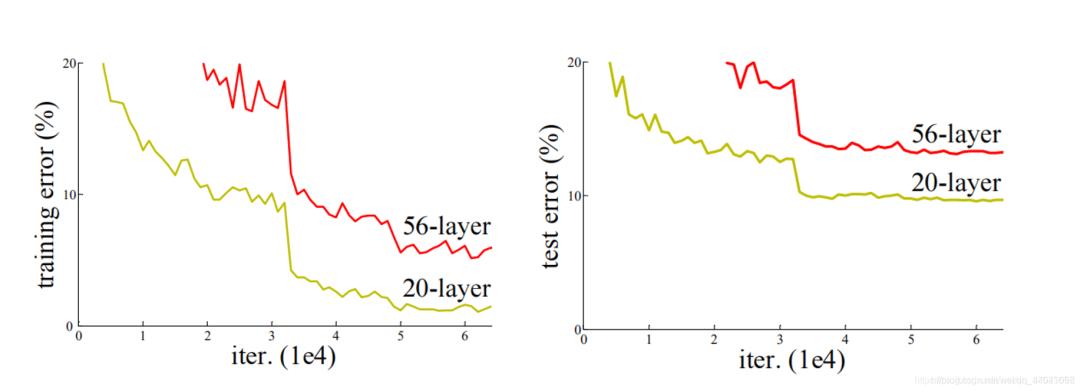 所以ResNet论文提出了residual结构(残差结构)来减轻退化问题。下图是使用residual结构的卷积网络,可以看到随着网络的不断加深,效果并没有变差,反而变的更好了。
所以ResNet论文提出了residual结构(残差结构)来减轻退化问题。下图是使用residual结构的卷积网络,可以看到随着网络的不断加深,效果并没有变差,反而变的更好了。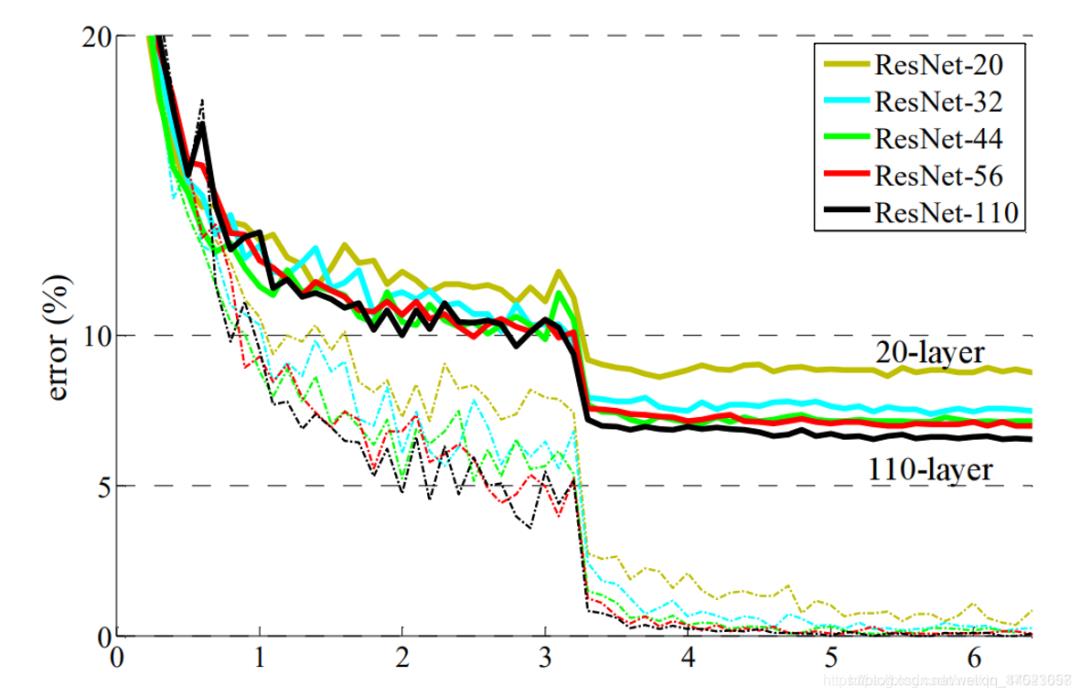 残差结构(residual)
残差结构(residual)
残差指的是什么?其中ResNet提出了两种mapping:一种是identity mapping,指的就是下图中”弯弯的曲线”,另一种residual mapping,指的就是除了”弯弯的曲线“那部分,所以最后的输出是 y=F(x)+x
-
identity mapping
顾名思义,就是指本身,也就是公式中的x,而residual mapping指的是“差”,也就是y−x,所以残差指的就是F(x)部分。
下图是论文中给出的两种残差结构。左边的残差结构是针对层数较少网络,例如ResNet18层和ResNet34层网络。右边是针对网络层数较多的网络,例如ResNet101,ResNet152等。为什么深层网络要使用右侧的残差结构呢。因为,右侧的残差结构能够减少网络参数与运算量。同样输入一个channel为256的特征矩阵,如果使用左侧的残差结构需要大约1170648个参数,但如果使用右侧的残差结构只需要69632个参数。明显搭建深层网络时,使用右侧的残差结构更合适。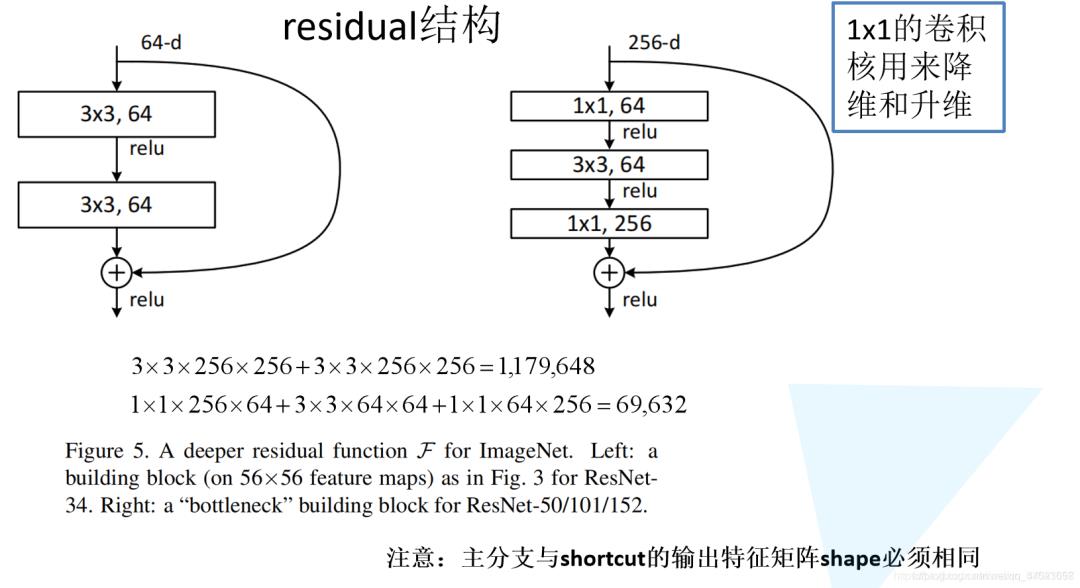 我们先对左侧的残差结构(针对ResNet18/34)进行一个分析。
我们先对左侧的残差结构(针对ResNet18/34)进行一个分析。
如下图所示,该残差结构的主分支是由两层3x3的卷积层组成,而残差结构右侧的连接线是shortcut分支也称捷径分支(注意为了让主分支上的输出矩阵能够与我们捷径分支上的输出矩阵进行相加,必须保证这两个输出特征矩阵有相同的shape)。如果刚刚仔细观察了ResNet34网络结构图的同学,应该能够发现图中会有一些虚线的残差结构。在原论文中作者只是简单说了这些虚线残差结构有降维的作用,并在捷径分支上通过1x1的卷积核进行降维处理。而下图右侧给出了详细的虚线残差结构,注意下每个卷积层的步距stride,以及捷径分支上的卷积核的个数(与主分支上的卷积核个数相同)。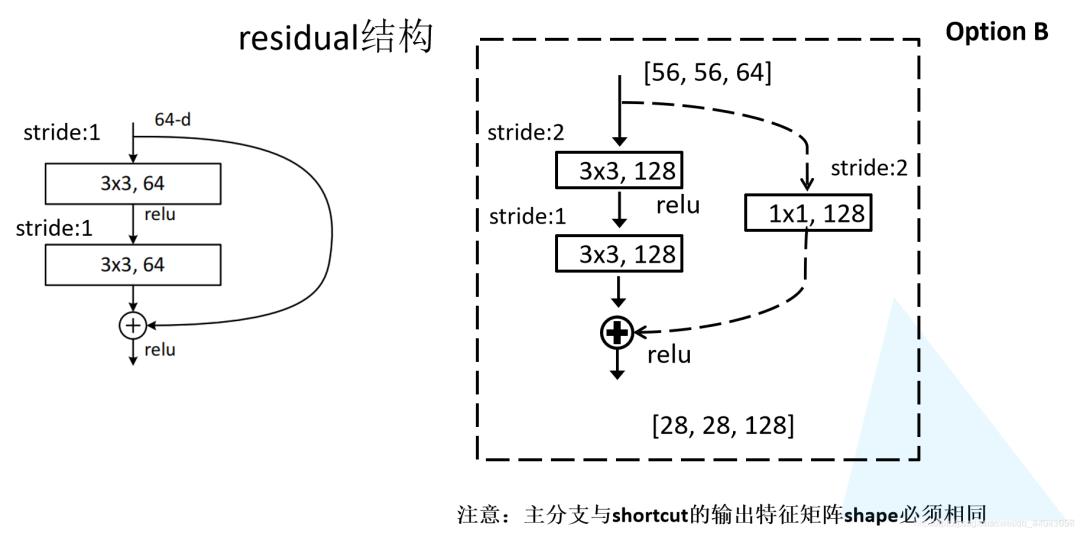 接着我们再来分析下针对ResNet50/101/152的残差结构,如下图所示。在该残差结构当中,主分支使用了三个卷积层,第一个是1x1的卷积层用来压缩channel维度,第二个是3x3的卷积层,第三个是1x1的卷积层用来还原channel维度(注意主分支上第一层卷积层和第二次卷积层所使用的卷积核个数是相同的,第三次是第一层的4倍)。该残差结构所对应的虚线残差结构如下图右侧所示,同样在捷径分支上有一层1x1的卷积层,它的卷积核个数与主分支上的第三层卷积层卷积核个数相同,注意每个卷积层的步距。
接着我们再来分析下针对ResNet50/101/152的残差结构,如下图所示。在该残差结构当中,主分支使用了三个卷积层,第一个是1x1的卷积层用来压缩channel维度,第二个是3x3的卷积层,第三个是1x1的卷积层用来还原channel维度(注意主分支上第一层卷积层和第二次卷积层所使用的卷积核个数是相同的,第三次是第一层的4倍)。该残差结构所对应的虚线残差结构如下图右侧所示,同样在捷径分支上有一层1x1的卷积层,它的卷积核个数与主分支上的第三层卷积层卷积核个数相同,注意每个卷积层的步距。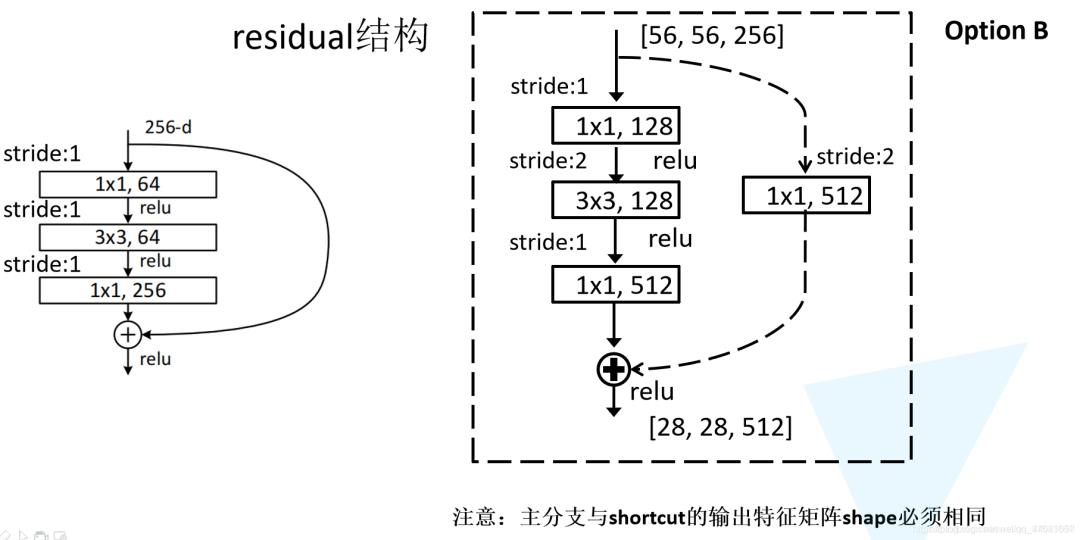 为什么残差学习相对更容易,从直观上看残差学习需要学习的内容少,因为残差一般会比较小,学习难度小点。不过我们可以从数学的角度来分析这个问题,首先残差单元可以表示为:
为什么残差学习相对更容易,从直观上看残差学习需要学习的内容少,因为残差一般会比较小,学习难度小点。不过我们可以从数学的角度来分析这个问题,首先残差单元可以表示为:
 其中 XL和 XL+1分别表示的是第L个残差单元的输入和输出,注意每个残差单元一般包含多层结构。F是残差函数,表示学习到的残差,而 h(XL)=XL表示恒等映射, F是ReLU激活函数。基于上式,我们求得从浅层 l到深层 L 的学习特征为:
其中 XL和 XL+1分别表示的是第L个残差单元的输入和输出,注意每个残差单元一般包含多层结构。F是残差函数,表示学习到的残差,而 h(XL)=XL表示恒等映射, F是ReLU激活函数。基于上式,我们求得从浅层 l到深层 L 的学习特征为: 式子的第一个因子表示的损失函数到达L的梯度,小括号中的1表明短路机制可以无损地传播梯度,而另外一项残差梯度则需要经过带有weights的层,梯度不是直接传递过来的。残差梯度不会那么巧全为-1,而且就算其比较小,有1的存在也不会导致梯度消失。所以残差学习会更容易。要注意上面的推导并不是严格的证明。
式子的第一个因子表示的损失函数到达L的梯度,小括号中的1表明短路机制可以无损地传播梯度,而另外一项残差梯度则需要经过带有weights的层,梯度不是直接传递过来的。残差梯度不会那么巧全为-1,而且就算其比较小,有1的存在也不会导致梯度消失。所以残差学习会更容易。要注意上面的推导并不是严格的证明。
下面这幅图是原论文给出的不同深度的ResNet网络结构配置,注意表中的残差结构给出了主分支上卷积核的大小与卷积核个数,表中的xN表示将该残差结构重复N次。那到底哪些残差结构是虚线残差结构呢。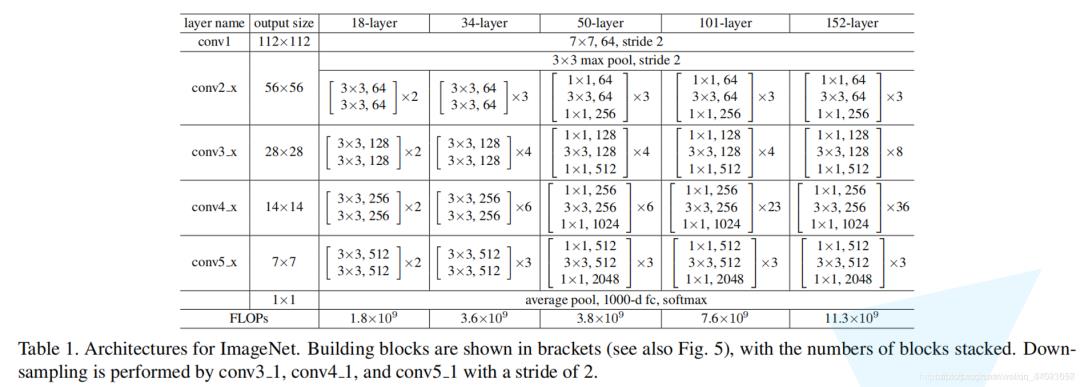 对于我们ResNet18/34/50/101/152,表中conv3_x, conv4_x, conv5_x所对应的一系列残差结构的第一层残差结构都是虚线残差结构。因为这一系列残差结构的第一层都有调整输入特征矩阵shape的使命(将特征矩阵的高和宽缩减为原来的一半,将深度channel调整成下一层残差结构所需要的channel)。为了方便理解,下面给出了ResNet34的网络结构图,图中简单标注了一些信息。
对于我们ResNet18/34/50/101/152,表中conv3_x, conv4_x, conv5_x所对应的一系列残差结构的第一层残差结构都是虚线残差结构。因为这一系列残差结构的第一层都有调整输入特征矩阵shape的使命(将特征矩阵的高和宽缩减为原来的一半,将深度channel调整成下一层残差结构所需要的channel)。为了方便理解,下面给出了ResNet34的网络结构图,图中简单标注了一些信息。
 对于我们ResNet50/101/152,其实在conv2_x所对应的一系列残差结构的第一层也是虚线残差结构。因为它需要调整输入特征矩阵的channel,根据表格可知通过3x3的max pool之后输出的特征矩阵shape应该是[56, 56, 64],但我们conv2_x所对应的一系列残差结构中的实线残差结构它们期望的输入特征矩阵shape是[56, 56, 256](因为这样才能保证输入输出特征矩阵shape相同,才能将捷径分支的输出与主分支的输出进行相加)。所以第一层残差结构需要将shape从[56, 56, 64] --> [56, 56, 256]。注意,这里只调整channel维度,高和宽不变(而conv3_x, conv4_x, conv5_x所对应的一系列残差结构的第一层虚线残差结构不仅要调整channel还要将高和宽缩减为原来的一半)。
对于我们ResNet50/101/152,其实在conv2_x所对应的一系列残差结构的第一层也是虚线残差结构。因为它需要调整输入特征矩阵的channel,根据表格可知通过3x3的max pool之后输出的特征矩阵shape应该是[56, 56, 64],但我们conv2_x所对应的一系列残差结构中的实线残差结构它们期望的输入特征矩阵shape是[56, 56, 256](因为这样才能保证输入输出特征矩阵shape相同,才能将捷径分支的输出与主分支的输出进行相加)。所以第一层残差结构需要将shape从[56, 56, 64] --> [56, 56, 256]。注意,这里只调整channel维度,高和宽不变(而conv3_x, conv4_x, conv5_x所对应的一系列残差结构的第一层虚线残差结构不仅要调整channel还要将高和宽缩减为原来的一半)。
代码
注:
-
本次训练集下载在AlexNet博客有详细解说:https://blog.csdn.net/weixin_44023658/article/details/105798326 -
使用迁移学习方法实现收录在我的这篇blog中:迁移学习 TransferLearning—通俗易懂地介绍(pytorch实例)
#model.py
import torch.nn as nn
import torch
#18/34
class BasicBlock(nn.Module):
expansion = 1 #每一个conv的卷积核个数的倍数
def __init__(self, in_channel, out_channel, stride=1, downsample=None):#downsample对应虚线残差结构
super(BasicBlock, self).__init__()
self.conv1 = nn.Conv2d(in_channels=in_channel, out_channels=out_channel,
kernel_size=3, stride=stride, padding=1, bias=False)
self.bn1 = nn.BatchNorm2d(out_channel)#BN处理
self.relu = nn.ReLU()
self.conv2 = nn.Conv2d(in_channels=out_channel, out_channels=out_channel,
kernel_size=3, stride=1, padding=1, bias=False)
self.bn2 = nn.BatchNorm2d(out_channel)
self.downsample = downsample
def forward(self, x):
identity = x #捷径上的输出值
if self.downsample is not None:
identity = self.downsample(x)
out = self.conv1(x)
out = self.bn1(out)
out = self.relu(out)
out = self.conv2(out)
out = self.bn2(out)
out += identity
out = self.relu(out)
return out
#50,101,152
class Bottleneck(nn.Module):
expansion = 4#4倍
def __init__(self, in_channel, out_channel, stride=1, downsample=None):
super(Bottleneck, self).__init__()
self.conv1 = nn.Conv2d(in_channels=in_channel, out_channels=out_channel,
kernel_size=1, stride=1, bias=False) # squeeze channels
self.bn1 = nn.BatchNorm2d(out_channel)
self.relu = nn.ReLU(inplace=True)
# -----------------------------------------
self.conv2 = nn.Conv2d(in_channels=out_channel, out_channels=out_channel,
kernel_size=3, stride=stride, bias=False, padding=1)
self.bn2 = nn.BatchNorm2d(out_channel)
self.relu = nn.ReLU(inplace=True)
# -----------------------------------------
self.conv3 = nn.Conv2d(in_channels=out_channel, out_channels=out_channel*self.expansion,#输出*4
kernel_size=1, stride=1, bias=False) # unsqueeze channels
self.bn3 = nn.BatchNorm2d(out_channel*self.expansion)
self.relu = nn.ReLU(inplace=True)
self.downsample = downsample
def forward(self, x):
identity = x
if self.downsample is not None:
identity = self.downsample(x)
out = self.conv1(x)
out = self.bn1(out)
out = self.relu(out)
out = self.conv2(out)
out = self.bn2(out)
out = self.relu(out)
out = self.conv3(out)
out = self.bn3(out)
out += identity
out = self.relu(out)
return out
class ResNet(nn.Module):
def __init__(self, block, blocks_num, num_classes=1000, include_top=True):#block残差结构 include_top为了之后搭建更加复杂的网络
super(ResNet, self).__init__()
self.include_top = include_top
self.in_channel = 64
self.conv1 = nn.Conv2d(3, self.in_channel, kernel_size=7, stride=2,
padding=3, bias=False)
self.bn1 = nn.BatchNorm2d(self.in_channel)
self.relu = nn.ReLU(inplace=True)
self.maxpool = nn.MaxPool2d(kernel_size=3, stride=2, padding=1)
self.layer1 = self._make_layer(block, 64, blocks_num[0])
self.layer2 = self._make_layer(block, 128, blocks_num[1], stride=2)
self.layer3 = self._make_layer(block, 256, blocks_num[2], stride=2)
self.layer4 = self._make_layer(block, 512, blocks_num[3], stride=2)
if self.include_top:
self.avgpool = nn.AdaptiveAvgPool2d((1, 1)) # output size = (1, 1)自适应
self.fc = nn.Linear(512 * block.expansion, num_classes)
for m in self.modules():
if isinstance(m, nn.Conv2d):
nn.init.kaiming_normal_(m.weight, mode='fan_out', nonlinearity='relu')
def _make_layer(self, block, channel, block_num, stride=1):
downsample = None
if stride != 1 or self.in_channel != channel * block.expansion:
downsample = nn.Sequential(
nn.Conv2d(self.in_channel, channel * block.expansion, kernel_size=1, stride=stride, bias=False),
nn.BatchNorm2d(channel * block.expansion))
layers = []
layers.append(block(self.in_channel, channel, downsample=downsample, stride=stride))
self.in_channel = channel * block.expansion
for _ in range(1, block_num):
layers.append(block(self.in_channel, channel))
return nn.Sequential(*layers)
def forward(self, x):
x = self.conv1(x)
x = self.bn1(x)
x = self.relu(x)
x = self.maxpool(x)
x = self.layer1(x)
x = self.layer2(x)
x = self.layer3(x)
x = self.layer4(x)
if self.include_top:
x = self.avgpool(x)
x = torch.flatten(x, 1)
x = self.fc(x)
return x
def resnet34(num_classes=1000, include_top=True):
return ResNet(BasicBlock, [3, 4, 6, 3], num_classes=num_classes, include_top=include_top)
def resnet101(num_classes=1000, include_top=True):
return ResNet(Bottleneck, [3, 4, 23, 3], num_classes=num_classes, include_top=include_top)
#train.py
import torch
import torch.nn as nn
from torchvision import transforms, datasets
import json
import matplotlib.pyplot as plt
import os
import torch.optim as optim
from model import resnet34, resnet101
import torchvision.models.resnet
device = torch.device("cuda:0" if torch.cuda.is_available() else "cpu")
print(device)
data_transform = {
"train": transforms.Compose([transforms.RandomResizedCrop(224),
transforms.RandomHorizontalFlip(),
transforms.ToTensor(),
transforms.Normalize([0.485, 0.456, 0.406], [0.229, 0.224, 0.225])]),#来自官网参数
"val": transforms.Compose([transforms.Resize(256),#将最小边长缩放到256
transforms.CenterCrop(224),
transforms.ToTensor(),
transforms.Normalize([0.485, 0.456, 0.406], [0.229, 0.224, 0.225])])}
data_root = os.getcwd()
image_path = data_root + "/flower_data/" # flower data set path
train_dataset = datasets.ImageFolder(root=image_path + "train",
transform=data_transform["train"])
train_num = len(train_dataset)
# {'daisy':0, 'dandelion':1, 'roses':2, 'sunflower':3, 'tulips':4}
flower_list = train_dataset.class_to_idx
cla_dict = dict((val, key) for key, val in flower_list.items())
# write dict into json file
json_str = json.dumps(cla_dict, indent=4)
with open('class_indices.json', 'w') as json_file:
json_file.write(json_str)
batch_size = 16
train_loader = torch.utils.data.DataLoader(train_dataset,
batch_size=batch_size, shuffle=True,
num_workers=0)
validate_dataset = datasets.ImageFolder(root=image_path + "/val",
transform=data_transform["val"])
val_num = len(validate_dataset)
validate_loader = torch.utils.data.DataLoader(validate_dataset,
batch_size=batch_size, shuffle=False,
num_workers=0)
#net = resnet34()
net = resnet34(num_classes=5)
# load pretrain weights
# model_weight_path = "./resnet34-pre.pth"
# missing_keys, unexpected_keys = net.load_state_dict(torch.load(model_weight_path), strict=False)#载入模型参数
# for param in net.parameters():
# param.requires_grad = False
# change fc layer structure
# inchannel = net.fc.in_features
# net.fc = nn.Linear(inchannel, 5)
net.to(device)
loss_function = nn.CrossEntropyLoss()
optimizer = optim.Adam(net.parameters(), lr=0.0001)
best_acc = 0.0
save_path = './resNet34.pth'
for epoch in range(3):
# train
net.train()
running_loss = 0.0
for step, data in enumerate(train_loader, start=0):
images, labels = data
optimizer.zero_grad()
logits = net(images.to(device))
loss = loss_function(logits, labels.to(device))
loss.backward()
optimizer.step()
# print statistics
running_loss += loss.item()
# print train process
rate = (step+1)/len(train_loader)
a = "*" * int(rate * 50)
b = "." * int((1 - rate) * 50)
print("
train loss: {:^3.0f}%[{}->{}]{:.4f}".format(int(rate*100), a, b, loss), end="")
print()
# validate
net.eval()
acc = 0.0 # accumulate accurate number / epoch
with torch.no_grad():
for val_data in validate_loader:
val_images, val_labels = val_data
outputs = net(val_images.to(device)) # eval model only have last output layer
# loss = loss_function(outputs, test_labels)
predict_y = torch.max(outputs, dim=1)[1]
acc += (predict_y == val_labels.to(device)).sum().item()
val_accurate = acc / val_num
if val_accurate > best_acc:
best_acc = val_accurate
torch.save(net.state_dict(), save_path)
print('[epoch %d] train_loss: %.3f test_accuracy: %.3f' %
(epoch + 1, running_loss / step, val_accurate))
print('Finished Training')
#predict.py
import torch
from model import resnet34
from PIL import Image
from torchvision import transforms
import matplotlib.pyplot as plt
import json
data_transform = transforms.Compose(
[transforms.Resize(256),
transforms.CenterCrop(224),
transforms.ToTensor(),
transforms.Normalize([0.485, 0.456, 0.406], [0.229, 0.224, 0.225])])
# load image
img = Image.open("./roses.jpg")
plt.imshow(img)
# [N, C, H, W]
img = data_transform(img)
# expand batch dimension
img = torch.unsqueeze(img, dim=0)
# read class_indict
try:
json_file = open('./class_indices.json', 'r')
class_indict = json.load(json_file)
except Exception as e:
print(e)
exit(-1)
# create model
model = resnet34(num_classes=5)
# load model weights
model_weight_path = "./resNet34.pth"
model.load_state_dict(torch.load(model_weight_path))
model.eval()
with torch.no_grad():
# predict class
output = torch.squeeze(model(img))
predict = torch.softmax(output, dim=0)
predict_cla = torch.argmax(predict).numpy()
print(class_indict[str(predict_cla)], predict[predict_cla].numpy())
plt.show()
以上是关于CNN经典网络模型:ResNet简介及代码实现(PyTorch超详细注释版)的主要内容,如果未能解决你的问题,请参考以下文章